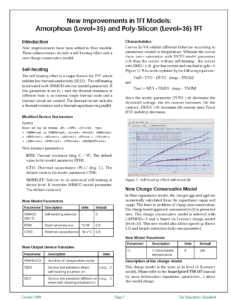New Improvements in TFT Models: Amorphous (Level=35) and Poly-Silicon (Level=36) TFT
Introduction
New improvements have been added to Shur models. These enhancements include a self-heating effect and a new charge conservative model.
Self-Heating
The self-heating effect is a major feature for TFT which exhibits low thermal conductivity ([1],[2]). The self-heating is activated with SHMOD selector (model parameter). If this parameter is set to 1 and the thermal resistance is different from 0, an internal single thermal node and a thermal circuit are created. The thermal circuit includes a thermal resistance and a thermal capacitance in parallel.
Modified Device Declaration
Syntax
Mxxx nd ng ns mname <M> <OFF> <IC=vds, vgs>
+ (TEMP=val or DTEMP=val) (L=val) (W=val) (NRS=val)
+ (NRD=val) (AD=val) (AS=val) (PD=val) (PS=val)
+ (GEO=val) (RTH=val) (CTH=val) (NOSELFT=val)
New instance parameters:
RTH: Thermal resistance (deg. C / W). The default value is the model parameter RTH0.
CTH: Thermal capacitance (W.s/ deg. C). The default value is the model parameter CTH0.
NOSELFT: Selector to de-activated self-heating at device level. It overrides SHMOD model parameter. The default value is 0.



